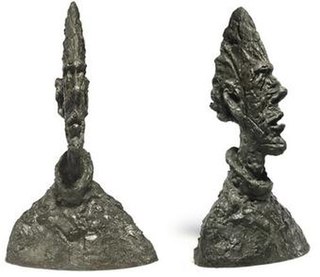
In ancient Greek religion and mythology, Artemis is the goddess of the hunt, the wilderness, wild animals, nature, vegetation, childbirth, care of children, and chastity. In later times, in some places, she was identified with Selene, the personification of the Moon. She often roamed the forests of Greece, attended by her large entourage, mostly made up of nymphs, some mortals, and hunters. The goddess Diana is her Roman equivalent.

Christie's is a British auction house founded in 1766 by James Christie. Its main premises are on King Street, St James's in London, and it has additional salerooms in New York, Paris, Hong Kong, Milan, Amsterdam, Geneva, Shanghai, and Dubai. It is owned by Groupe Artémis, the holding company of François-Henri Pinault. In 2022 Christie's sold $8.4 billion in art and luxury goods, an all-time high for any auction house. In 2017, the Salvator Mundi was sold at Christie's in New York for $450 million, the highest price ever paid for a single painting.

Clyfford Still was an American painter, and one of the leading figures in the first generation of Abstract Expressionists, who developed a new, powerful approach to painting in the years immediately following World War II. Still has been credited with laying the groundwork for the movement, as his shift from representational to abstract painting occurred between 1938 and 1942, earlier than his colleagues like Jackson Pollock and Mark Rothko, who continued to paint in figurative-surrealist styles well into the 1940s.

Sotheby's is a British-founded American multinational corporation with headquarters in New York City. It is one of the world's largest brokers of fine and decorative art, jewellery, and collectibles. It has 80 locations in 40 countries, and maintains a significant presence in the UK.

The Buffalo AKG Art Museum, formerly known as the Albright–Knox Art Gallery, is an art museum in Buffalo, New York, in Delaware Park. The museum was expanded beginning in 2021, and re-opened in June 2023.

Crystal Bridges Museum of American Art is a museum of American art in Bentonville, Arkansas. The museum, founded by Alice Walton and designed by Moshe Safdie, officially opened on 11 November 2011. It offers free public admission.

The Diana of Versailles or Artemis, Goddess of the Hunt is a slightly over-lifesize marble statue of the Roman goddess Diana with a deer. It is currently located in the Musée du Louvre, Paris. The statue is also known as Diana with a Doe, Diana Huntress, and Diana of Ephesus. It is a partially restored Roman copy of a lost Greek bronze original attributed to Leochares, c. 325 BC.
The year 2007 in art involved some significant events and new works.
Shaun Greenhalgh is a British artist and former art forger. Over a seventeen-year period, between 1989 and 2006, he produced a large number of forgeries. With the assistance of his brother and elderly parents, who fronted the sales side of the operation, he successfully sold his fakes internationally to museums, auction houses, and private buyers, accruing nearly £1 million.

The Guennol Lioness[ˈɡwɛnɔl] is a 5,000-year-old Mesopotamian statue allegedly found near Baghdad, Iraq. Depicting a muscular anthropomorphic leonine-human, it sold for $57.2 million at Sotheby's auction house on December 5, 2007. The sculpture had been acquired by a private collector, Alastair Bradley Martin, in 1948 from the collection of Joseph Brummer, and had been on display at Brooklyn Museum of Art in New York City from that time to its sale in 2007. It is called "Guennol" after the Welsh name for "Martin", the name of the collector. In 1950 Edith Porada described it as a lioness "because of the feminine curves of her lower body and the absence of male organs" while conceding the possibility "that the figure represented a sexless creature".
Giuseppe Panza di Biumo was a collector of modern art. He lived in Milan and Varese, Italy.
L’Homme qui marche I is the name of any one of the cast bronze sculptures that comprise six numbered editions plus four artist proofs created by Swiss sculptor Alberto Giacometti in 1961. On 3 February 2010, the second edition of the cast of the sculpture became one of the most expensive works of art ever sold at auction, for $104.3 million. Its price meant it was considered the most expensive sculpture, until May 2015, when another Giacometti work, L'Homme au doigt, surpassed it.

Grande tête mince is a bronze sculpture by Alberto Giacometti. The work was conceived in 1954 and cast the following year. Auctioned in 2010, Grande tête mince became one of the most valuable sculptures ever sold when it fetched $53.3 million.

Tête de femme is a plaster-modelled, bronze-cast sculpture by Pablo Picasso. Dora Maar, Picasso's lover at the time, was the subject of the work which was originally conceived in 1941. Four copies of the bust were cast in the 1950s, several years after the relationship ended.

Banality is a series of sculptures by American artist Jeff Koons. The works were unveiled in 1988 and have become controversial for their use of copyrighted images. Several editions of the sculptures have sold at auction for millions of dollars.

L'Homme au doigt is a 1947 bronze sculpture by Alberto Giacometti, that became the most expensive sculpture ever when it sold for US$141.3 million on May 11, 2015.

Deaccessioning is the process by which a work of art or other object is permanently removed from a museum's collection to sell it or otherwise dispose of it.












